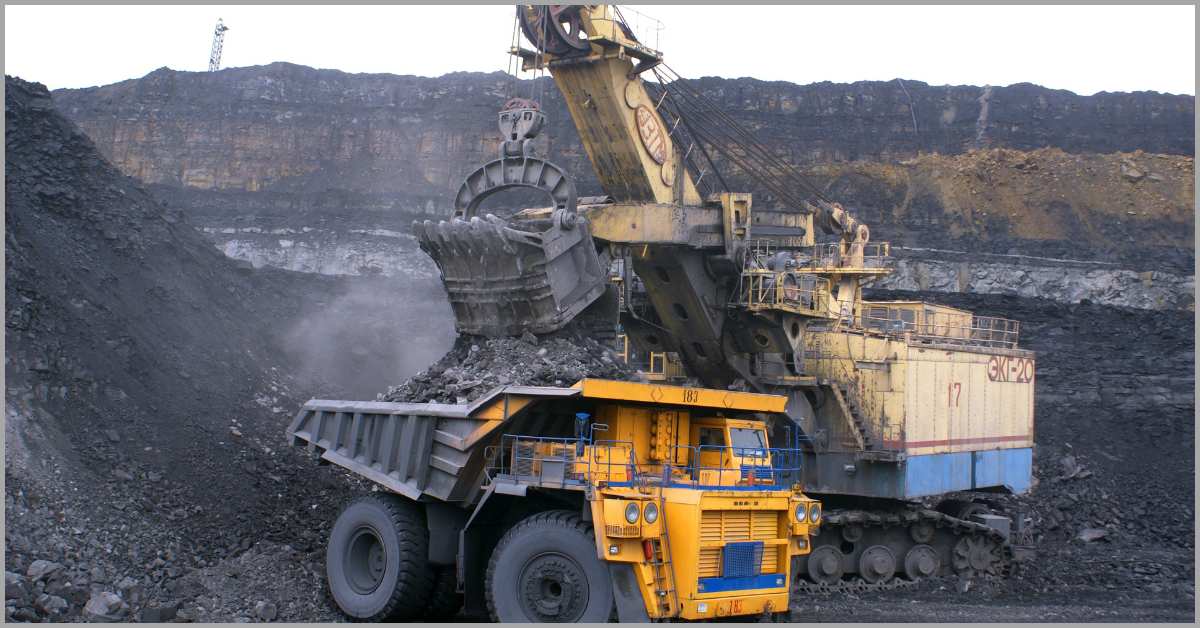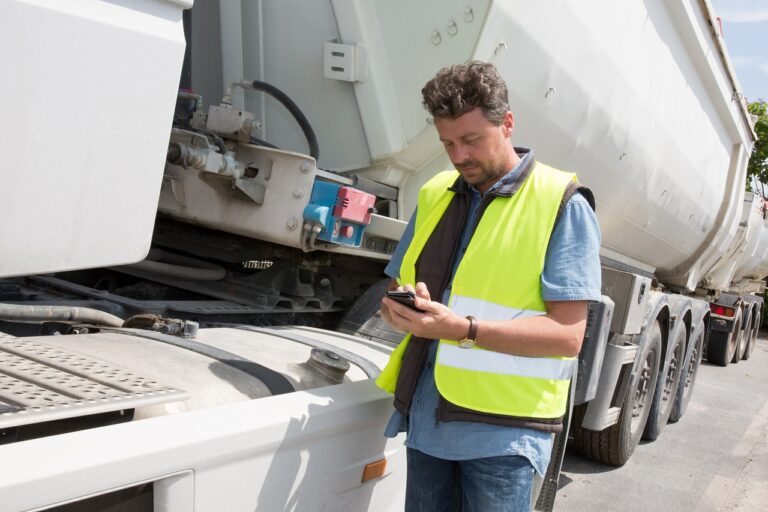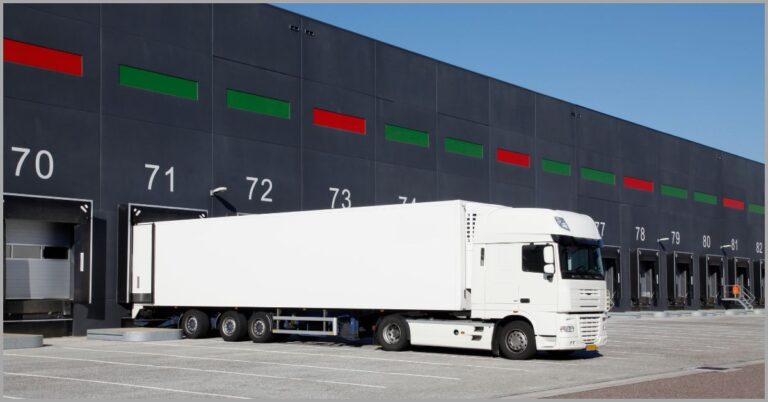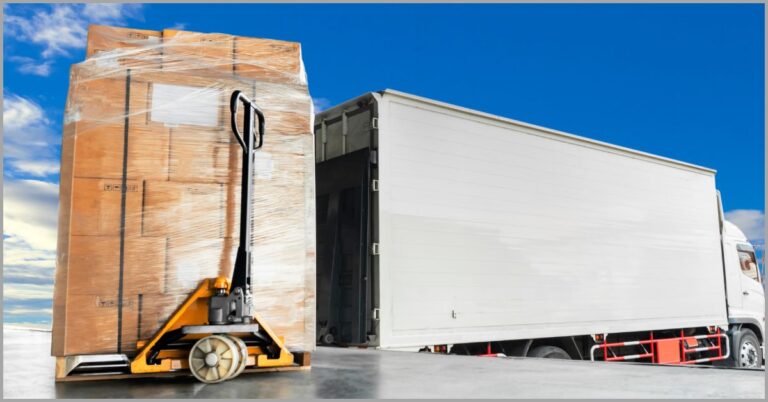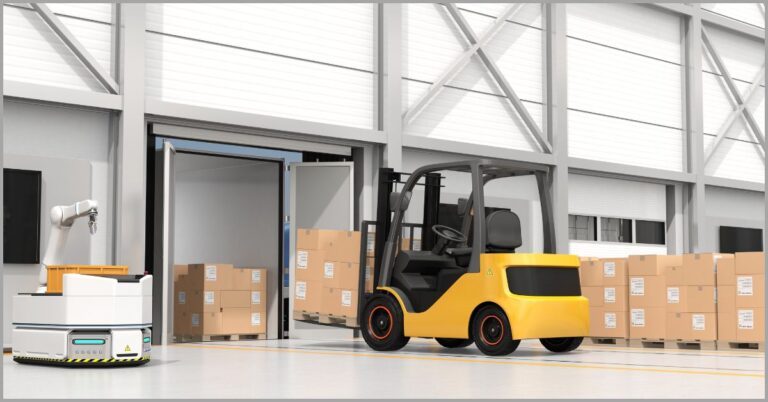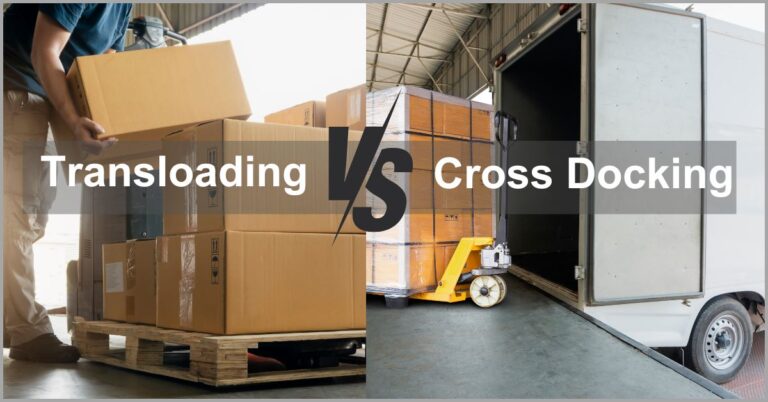What is Coal Transloading? Ultimate Guide to Shipping this Powerful Commodity in 2024
Want to start transloading coal for your business?
This is among the in-trend logistics innovations and strategies redefining shipping.
Nonetheless, figuring out the latest trends and effective coal transloading techniques is essential to getting it right and maximizing ROI.
A Gartner study revealed that 76% of new logistics projects fail. So exploring new strategies like coal transloading requires a well-thought-out approach.
In order to help you start transloading coal for your business, we’ll go over essential insights on how the process works and key infrastructure requirements. This will enable you to invest in the right technologies and expertise.
We’ll also discuss important challenges that affect the process so that you can avoid the obstacles and hazards that come with transloading this product.
If you’d like to explore other profitable transloading strategies, check out this article I wrote about different types of transloading and what they offer.
In this article, we’ll discuss what coal transloading is as we unpack the ultimate guide to shipping this powerful commodity in 2024 to help you improve business revenue.
Let’s get started.
What is coal transloading
So what is coal transloading?
Coal transloading is the transfer of coal from one mode of transportation to another. For example, if you move coal from a dump truck onto railcars to transport it to a refinery plant, you’re considered to have transloaded the coal.
Transloading is a great way for you to get around the capacity limits of trucks and avoid sending your shipment in smaller and less cost-efficient batches.
Other times, it’s a process that’s very necessary if you’re mining in areas where poor road networks make it difficult to ship coal by truck. This is where coal railcars come in, helping you to move the product from very remote areas to refineries.
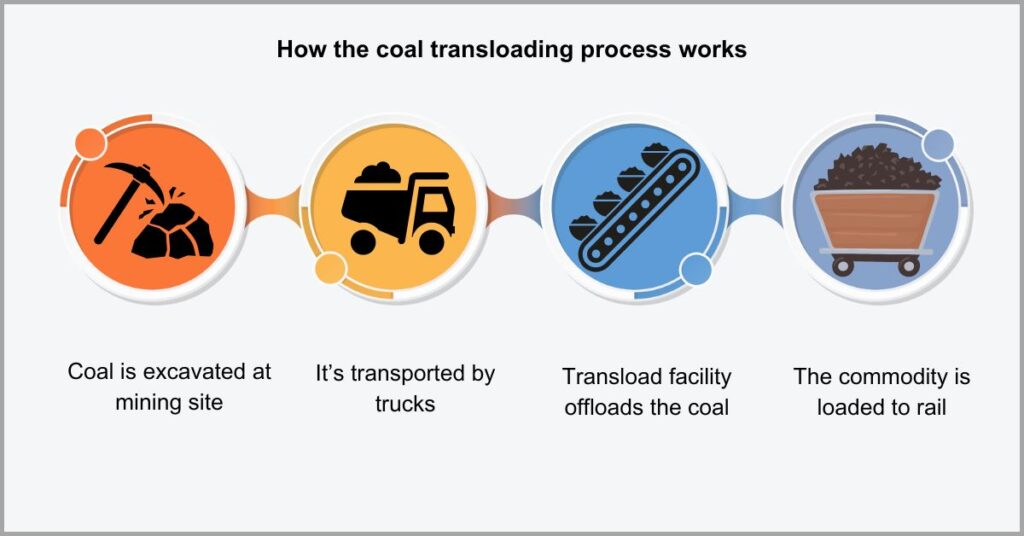
With transload shipping, you can efficiently transport unprocessed & processed coal.
While there are several types of coal, we can generally classify them into two categories, namely commercial and domestic. Each may attract unique transloading needs depending on whether you require additional services like repackaging.
Overall, the process of transloading coal can involve complex logistics because of the switching between different modes of transport. So I recommend using a transloading software to make logistics management more efficient.
Click here to start your free transloads.co trial to improve coal transload management. With our software, you can track inbound and outbound coal shipments from a central viewpoint, and oversee logistics in real time to streamline your shipping processes.
How a coal transloading facility works
A coal transloading facility is a crucial supply chain partner.
They can help to efficiently and safely move coal, which can be a very dangerous product to ship due its flammable properties that attract the risk of explosions.
With a transload facility that enforces the proper handling, mid-transit storage and transfer of coal, you can avoid the safety risks that come with coal shipping.
But how exactly does a facility for transloading coal work?
Well, the transload yard is usually the first place your coal shipment will reach after it’s excavated from the mining site. You’ll need to move it here using several 15 to 60 ton trucks depending on the size of your shipment.
In order to enable you to use rail, they’ll now transfer the coal from trucks onto open rail wagons. They’ll typically use special transloading equipment such as conveyor belts to switch the commodity between the different modes of transportation.
These conveyor belts may be different from ordinary ones, incorporating special properties for safer coal transloading. For instance, they may leverage flame resistant, high quality rubber to lower the risk of sparks and spontaneous combustion.
Beyond first mile delivery, the facility can also help with last-mile shipments.
If you’ve already refined coal and perhaps even packed it into bags for end users, transloading services are even more beneficial. They can consolidate and deconsolidate coal freight to enable it to reach multiple retailers by trucks.
Benefits of transloading coal for your business
1. Freight reworks
You may need to move coal in sacks.
This can happen during the last-mile delivery phase of your supply chain, when you’re shipping coal to your final end user across domestic or commercial markets.
However, coal has abrasive properties and this means that packaging you use, such as sacks, for example, can easily get torn during the shipping process.
A survey by Averitt revealed that 34% of shippers experienced at least one incident of cargo damage in 2023. While it signified a 10% decrease from 2016, it still remains a massive concern.
Your transloading facility may offer freight reworking services to remove and repair damaged packaging during shipping.
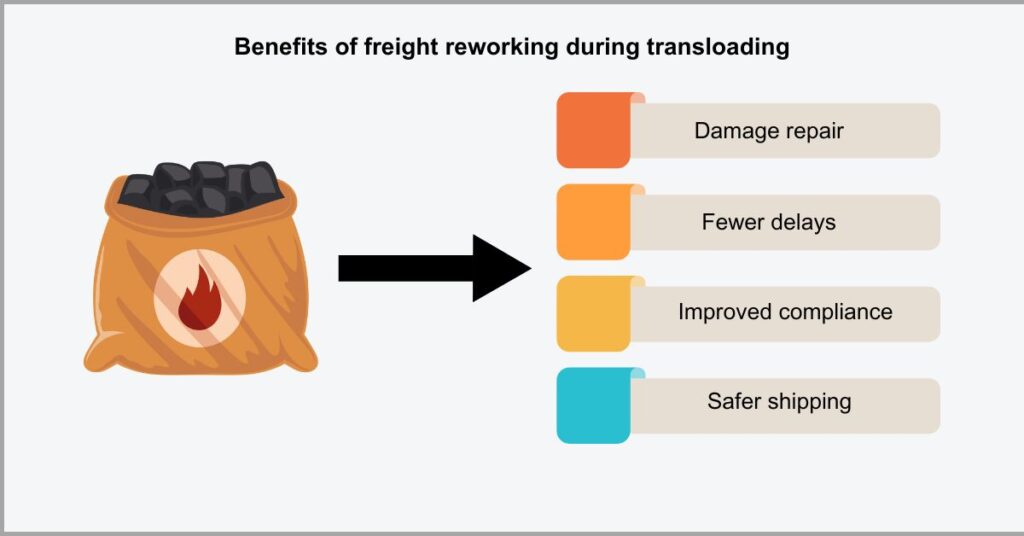
So what is freight reworking during transloading?
It refers to the process of unloading your freight and repairing damaged pallets, sacks or bags that house the commodities you’re shipping. Afterward, the freight is returned to its packaging to continue its journey along your supply chain.
Freight reworking is very important during rail transload shipping. It can help you transfer and repackage coal into heavy duty and tear resistance sacks, which ensure safer transportation and more presentable market-ready commodities.
But it isn’t just about damage to the shipment.
In case of damage to a trailer that’s transporting the product, transloading enables you to unload the coal and temporarily house it until a new trailer becomes available.
2. Increased freight capacity
So what is freight capacity and why does it matter?
It simply refers to the volume of your shipment that a particular transport carrier can handle at a given time. This is an important factor because it directly affects the throughput of your supply chain.
When you’re dealing with low freight capacity carriers, you’ll have more coal volume to move than there is transportation available, thus creating delays.
A survey by FourKites revealed that 44% of shippers cite over-the-road capacity constraints as a big issue during shipping. From the survey results, this was the second biggest challenge overall.
Transloading coal, however, is key to improving your freight capacity.
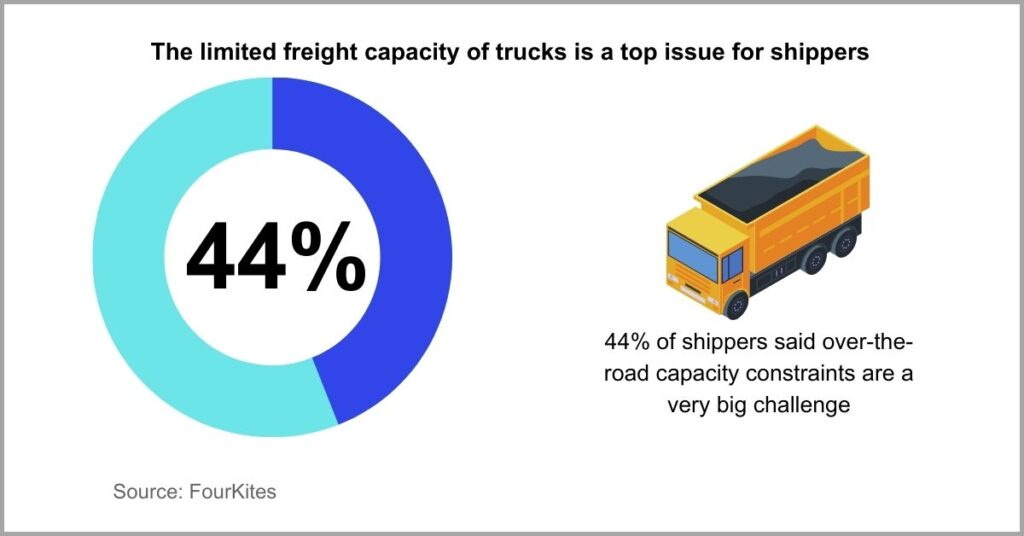
For example, it enables you to transfer coal from low-capacity trucks to high capacity railcars. With trains able to accommodate larger volumes per unit compared to trucks, they enable you to ship more coal within the same timeframe.
You may also get transloading and cross docking services. These enable you to switch coal from low capacity trailers to heavy duty trucks with increased load volumes.
Another way it improves freight capacity is by enabling train to barge coal transfers.
With a 15 barge tow capable of handling the loads of 216 rail cars or 1,050 trucks, this type of transloading enables you to move much larger volumes of coal in one go.
3. Simplified logistics
Coal can also attract complex logistics.
Oftentimes, you may need to break up the commodity into smaller shipments because of transport capacity constraints. The result is several, smaller consignments that you need to track and manage as separate entities or cargo.
With each shipment creating its own logistics, your coal shipping process becomes less efficient while this also attracts supply chain visibility issues.
A survey by McKinsey revealed that 9 in 10 supply chain leaders enouncted logistics challenges in 2024. Chief among their most pressing issues were limited visibility into these networks as well as complex & ineffective logistics that increase disruption risks.
Coal transloading can solve these issues to lower your logistics management burden.
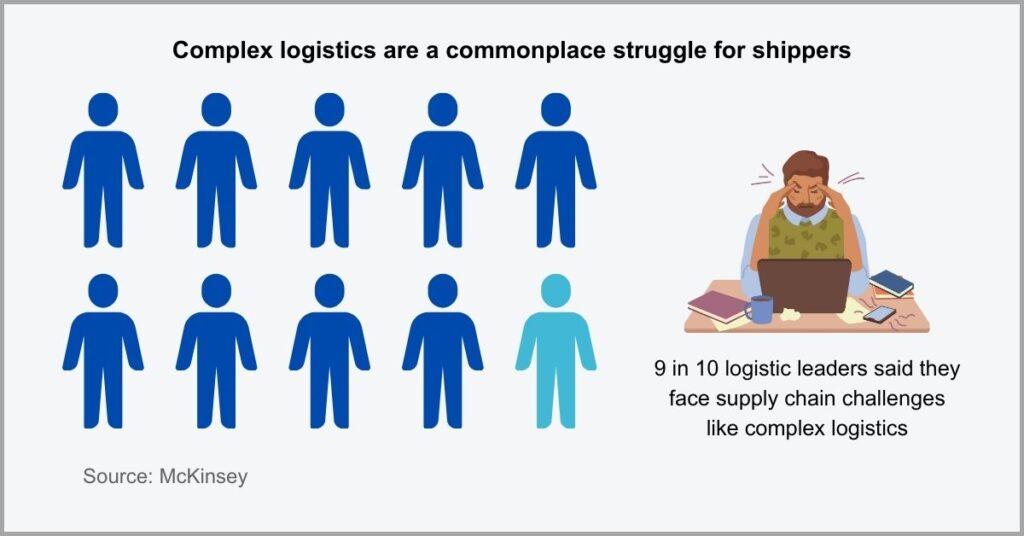
So how does transloading simplify logistics?
It enables you to consolidate coal shipments into one or larger consignments that are much easier to keep tabs on and coordinate. The result is also lower inventory splitting and management needs for your business.
Additionally, in place of inefficient spreadsheets, emails and phone calls, transloaders may leverage the best transload management software. They facilitate real-time shipment tracking, which simplifies your logistics and improves supply chain visibility.
With these tools offering digital documents and customer portals, they further minimize your logistics needs and the need for outsourcing the process. You can keep most of your logistics in-house to ensure great control over your supply chain.
4. Expanded market reach
Struggling to grow your market and supply chain?
For your business to grow and thrive, market expansion is necessarily to help you reach even more end users and generate revenue to create a healthy cash flow.
However, when the reach of your supply chain is limited due to geographical barriers, that means you can access fewer markets and customers.
The coal market was valued at $1.4 trillion in 2022, and it’s growing at a compound rate of 4.4% per year, according to a TMR study. With transloading, you can make inroads into new coal markets and generate even more revenue for your business.
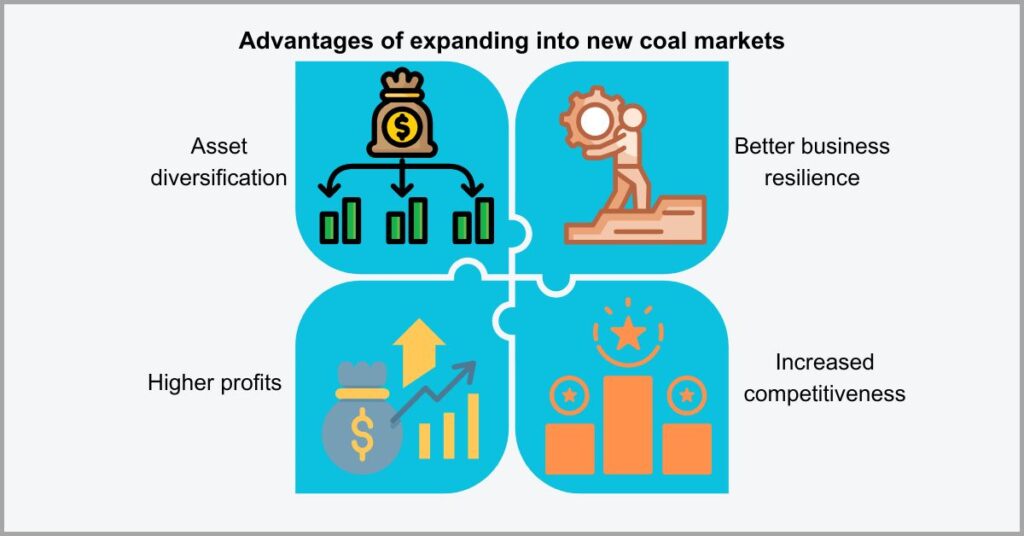
When you transload coal, you can open up new opportunities for your business.
For example, it enables you to leverage critical railroad logistics and infrastructure to get to far-flung destinations. This enables you to ship coal to markets that aren’t directly served by road infrastructure therefore enabling you to widen your sales net.
In areas with limited rail networks, you can also switch to trucks to get around geographical barriers for your business. Beyond that, transloading also gives you temporary warehousing in strategic locations.
So you can easily store your products close to important markets in your supply chain, consequently ensuring excellent coal availability to meet sudden hikes in demand.
5. Supply chain resilience
Your supply chain is under serious attack.
When it comes to shipping, in particular, carrier delays, extreme weather and other transportation issues can stall shipping operations and cause downtime.
With each supply chain disruption, your business can’t get coal to its customers on time or at all, resulting in revenue losses and customer frustration.
In fact, a survey by Deloitte revealed that 75% of companies greatly value supply chain resilience. Given how it directly affects not only your cash flow but also your company’s reputation, it’s understandable why it’s seen as a very important aspect of success.
One way to boost the resilience of your shipping networks is by transloading coal.
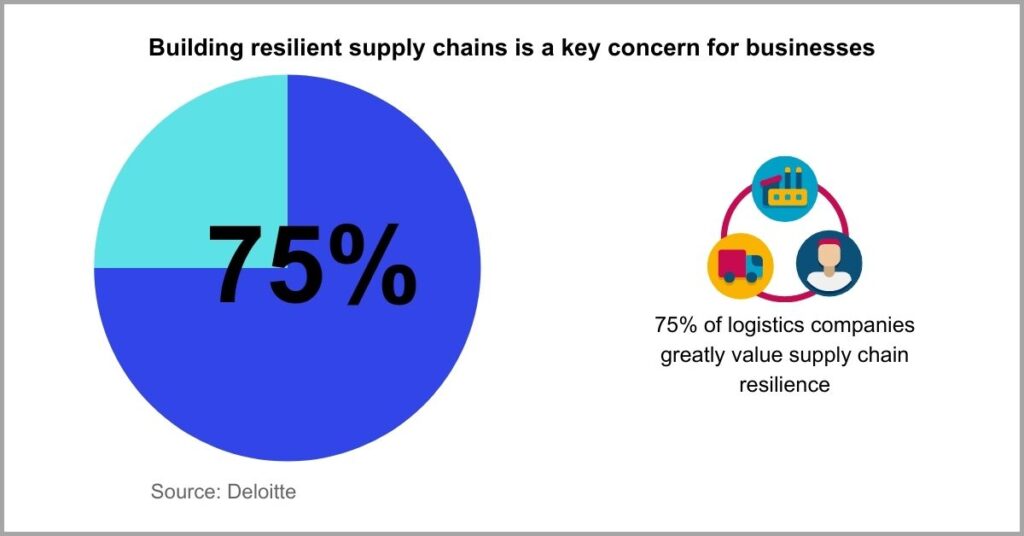
It enables you to switch coal between trucks, rail and even barges, allowing you to diversify your shipping routes, carriers and modes of shipping.
In case there’s a disruption because of issues like road or port congestion due to container shortages, for example, you can switch to alternative transportation. This enables you to keep your supply chain flowing.
If you’re keen to start a coal transloading facility to maximize supply chain resilience, we can help you get started.
Click here to get our premium support services to improve transloading success.
We’ll guide you on how to set up your transload yard, source skilled transload operators, and optimize operations to make transloading more efficient & profitable.
Challenges of transloading coal
I. Safety risks
Coal is a highly combustible product.
During the transloading process, explosive dust can form as you transfer it between trucks and railcars. Moving bulk quantities of coal also lead to self-heating as the stones rub against each other, further increasing the risk of fires and explosions.
What’s more, coal may also emit toxic methane fumes that raise the risk of respiratory complications and other long-term physical health issues.
A survey by WTW revealed that 63% of logistics businesses noticed an increase in supply chain losses stemming from various risks. These include fires, explosions and other accidents that can occur during your transload shipping processes.
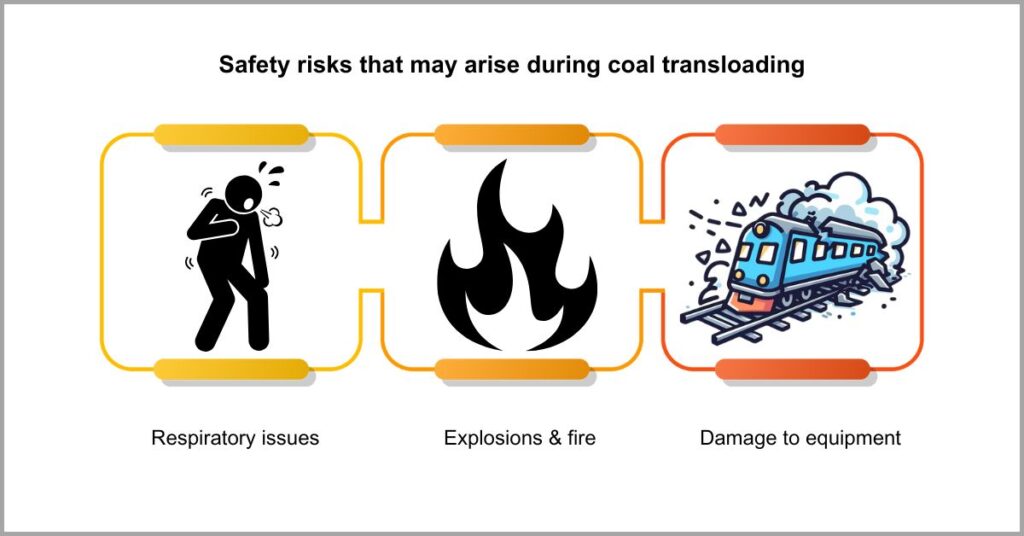
So it’s crucial to implement various safety measures to ensure safe coal transfers and get around common transloading challenges such as accidents.
One of those entails creating a detailed safety manual for transloaders.
This should describe appropriate personal protective equipment to wear, such as the type of respirators, safety caps, and face shields, among others. It should also define best practices to follow to ensure the safe handling and unloading of coal.
It also helps to have dedicated safety personnel to specifically take charge of overseeing the transloading and ensuring everything is done as per safety standards.
II. Extreme weather
How does weather affect coal transloading?
It’s highly likely that you transport coal via open trucks or open rail wagons, which exposes it directly to weather elements and subzero temperatures.
During winter months, coal can freeze in rail cars, barges and storage containers, making the transloading process more difficult and time-consuming.
Extreme weather conditions is a top challenge for 39% of shippers, according to a survey by Breakthrough. This makes it the biggest struggle among shipers, ranking ahead of other important issues like limited freight capacity & driver shortages.
While you can’t control the weather, you can take steps to mitigate its effects.
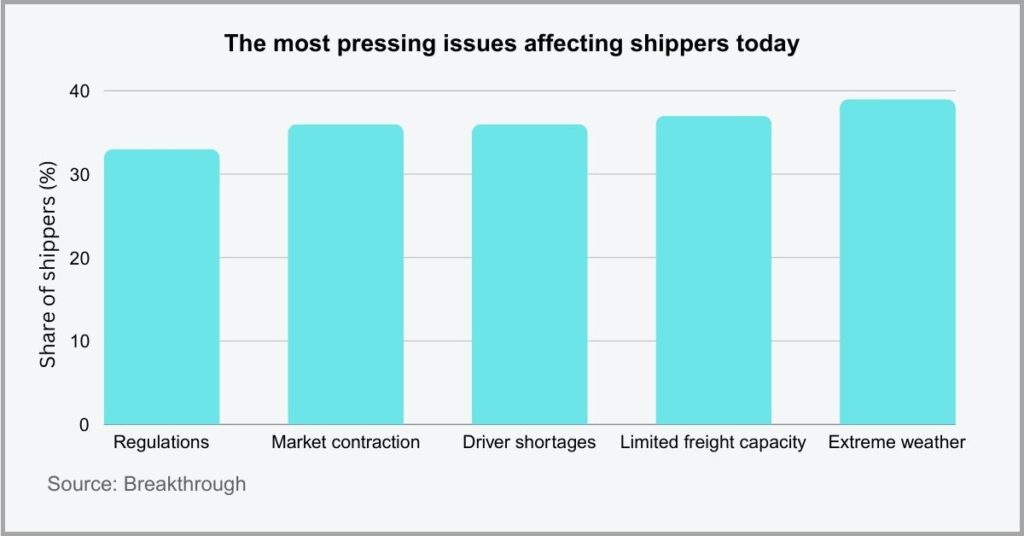
You can borrow a leaf from different types of transloading facilities that use tactics like adding antifreeze additives to railcars. This lowers the freezing point of the ice, ensuring that the coal dumps out of the railcar more effortlessly during unloading.
I also recommend that you look into special equipment like rubberized conveyor belts and temperature-controlled storage silos. These can help reduce the risk of ice formations during the loading, offloading and storage of coal at your facility.
Aside from streamlining transloading, safeguarding coal during winter can also reduce claims and disputes resulting from your customers receiving frozen stock.
III. Strict regulations
There are strict regulations around coal handling.
For instance, the International Maritime and Dangerous Goods (IMDG) code classifies coal as a category 4.2 dangerous good due to its ability to combust spontaneously.
So when you’re transloading, storing and handling coal, you need to take measures to avoid non-compliance that invites various regulatory penalties.
A survey by IATA revealed that 72% of shippers are struggling with dangerous goods compliance. In particular, some of the most common challenges revolved around cargo misdeclaration and poor handling of these commodities.
How do you navigate coal transloading compliance issues?
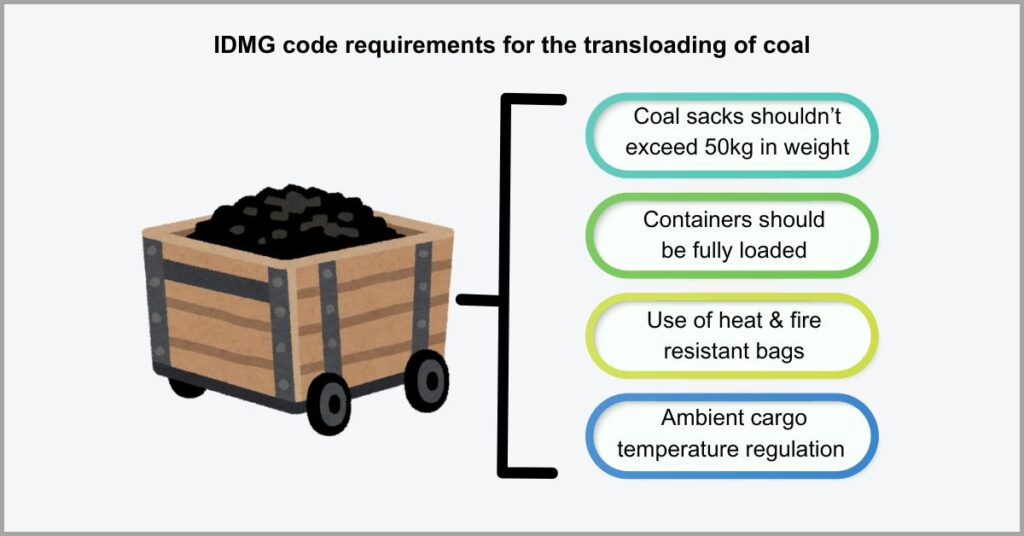
It helps to know what these regulations are in the first place.
In the case of the IMDG code, its provisions require that you perform a spontaneous combustion laboratory test before you begin shipping. You can find these requirements under the Chapter 33 provision of the code.
So before you start a warehouse business for transloading coal, it’s important to ensure that you have the necessary infrastructure in place to streamline compliance.
Furthermore, you also need to make coal packaging both water and heat resistant. Regulations also require the strategic selection and filing of containers to reduce the amount of oxygen available that can catalyze an ignition during shipping.
Conclusion
Transloading coal requires specialized tools.
This can include conveyor systems, reach stackers and even digital tools like transloading software.
Without the special technology & training you need to work with coal, transloading this commodity can be very unsafe and inefficient for your business.
A survey by McKinsey established that 93% of businesses plan to invest more in supply chain technologies. One area they’re challenging funds into is transloading software to ensure the safe and efficient management of shipping operations.
When you invest in the right equipment, digital tools and staff skills, you can improve shipping efficiency and make coal transloading work. In turn, you can expand your market, increase freight profits and improve your business’s success.
Click here to start your free transloads.co trial for more efficient coal transloading.
With our software, you can track coal shipments with ease, assign transloading tasks centrally and enhance collaboration to improve your coal shipping processes.

